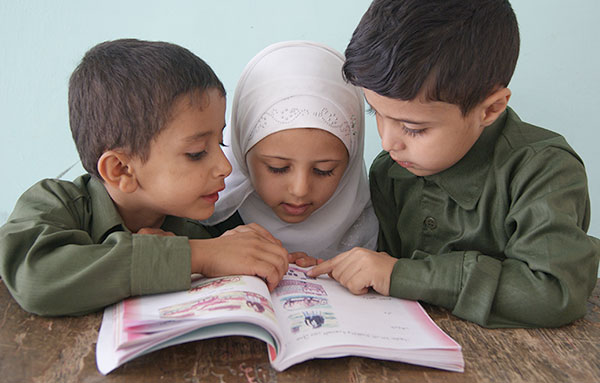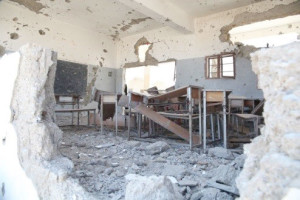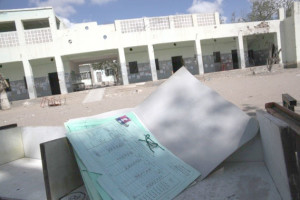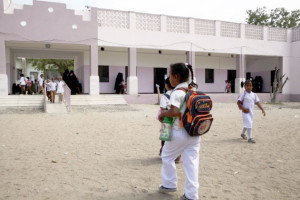
For Arabic, click here.
.لقراءة المقال باللغة العربية، انقر هنا
Until March 2015, when conflict escalated, 1.3 million first, second and third graders were learning to read in Arabic throughout Yemen, even in the midst of conflict.
With support from the U.S. Agency for International Development and other international donors, the Ministry of Education was scaling up a new national education reform that included the early grade reading project. Creative Associates International has provided technical and implementation support on the ground since 2010.
With the escalation of Yemen’s conflict at the end of March, nearly all education activities have come to a grinding halt. The UN Humanitarian Coordinator for Yemen, Johannes Van Der Klaauw, estimated that 2 million children were unable to attend school.
Unfortunately, the conflict has caused tremendous losses, including the lives of children. Some schools have been destroyed, while most universities and schools have closed out of concern for safety.
Education promotes stabilization
Education in times of conflict plays a vital role in rebuilding crisis-affected communities, creating a sense of stability and preparing residents for a peaceful future. Safe schools create a protective environment for learning and healing.
Higher national levels of education are correlated with lower risks of armed conflict. Quality and conflict-sensitive education can help stabilize societies and improve economic and social well-being.
A UN “Report of the Secretary General on peacebuilding in the aftermath of conflict” finds that “in conflict-affected situations, education is more than service delivery and is a means of socialization and identity development through the transmission of knowledge, skills, values and attitudes across generations.”
Thus, while education can be a potential driver of conflict if co-opted (fueling grievances, stereotypes and xenophobia), it can also contribute to conflict transformation and peacebuilding when implemented in an inclusive and conflict-sensitive way.
Donors should not only continue and ramp up education support during the present crisis in Yemen but also prepare for post-conflict education development.
Robust & strategic education aid

The resumption of international aid for Yemen’s education development, especially in post-conflict Yemen, will need to be strategic and robust.
In the initial stages, school and Ministry of Education infrastructure will need rehabilitation from the damage and destruction of schools during the conflict. Displaced children and families may need access to host community schools, child-friendly spaces or other temporary learning centers.
Education can play a protective role. Research and practice shows that schools, learning environments and educators can help support children’s well-being and healthy development. Aid should enable education programs to be participatory, supportive, child- and youth-friendly, and free of humiliation and abuse.
Integrated, school-based support for vulnerable groups, such as children associated with fighting forces and armed groups, will be needed. Psychosocial support for educators also reduces conflict-related stress and anxiety.
Children who have been out of school will require “catch up” programs in order to finish their education or make up lost time. School rehabilitation, with a strong role for parents and community members, will help restore a sense of hope and normalcy and create secure learning environments. Keeping schools functioning in Yemen can also help communities to understand underlying causes of conflict and strengthen anti-violence messages.
Yemen sits at the bottom of the Arab world in a number of education-related measures, according to the Brookings Institution’s Arab World Learning Barometer. Student learning gains in Yemen are the lowest among all Arab states with 91 percent of primary students not meeting basic learning levels. Dropout among Yemeni primary students has declined over the last 10 years, but remains the highest in the Arab world.

Yemen’s education needs before the recent conflict were many. The Ministry of Education, with support from international donors, has had ambitious plans, including increasing the number of classrooms and reducing double shifts; boosting the percentage and quality of female teachers; raising student enrollment, especially for girls; and reforming early grade reading and math through grade five.
The Ministry of Education will need long-term and robust assistance to achieve its goals, which may include measures to redress issues arising from the conflict (i.e. curriculum reform and decentralization).
In a post-conflict Yemen, with new personnel in place, the Ministry of Education will also require support with capacity building and strengthening its systems. Making these plans a reality will take robust, strategic and sustained efforts to maintain the progress made in reading and other areas, and re-establish the education system.
A model for education during and after conflict
The systemic, transparent and inclusive approach to reading reform under the Yemen Early Grade Reading Approach has not only strengthened literacy and the national education system, but has also increased stability and security for students, families and communities. This program can serve as a model for carrying out quality education programming in the midst of conflict and for rebuilding Yemen post-conflict.
Yemen’s Ministry-led national reading reform has served as a critical unifying force prior to the recent conflict. Continued support for this and similar education reforms post conflict has the potential to move the country towards peace.
Through the program, parents, community members and education officials have come together to work towards the common goals of improving literacy, preventing dropout and giving children the educational foundation they need for economic advancement.
The program has helped build stronger relationships between parents, teachers and children. Parents are spending more time with their children on reading at home and are interacting more closely with teachers to boost their children’s reading.
Sharing these common goals and working to realize them, even in the middle of conflict, has laid the ground for strong communities and schools that will be critical to post-conflict stabilization.
The program has also emphasized gender parity in the classroom among students and teachers—there are more female teachers than males in the lower primary grades. Research shows that when girls complete secondary school fertility rates decline, child marriage decreases, strong socioeconomic indicators rise and communities become more resistant to violence.
Today, Yemeni primary school children arguably have the best chance of any cohort in recent memory of staying in school, achieving academic success and completing high school— one of the best predictors for reducing the potential for conflict.
Thus, sustaining attention to and continuing the implementation of these education gains in Yemen, should guide our current and future education response.
The children cannot wait

Today, thousands of grade one students in Yemen only completed half a year of schooling due to conflict. What will happen to them?
Societies that are unable to continue education programs because of conflict are at a greater risk of getting trapped in vicious cycles where education is consistently interrupted by war. This in turn increases their risk of armed conflict in the future. Young people are missing out on valuable years of education.
We call upon all actors—USAID, the Global Partnership for Education, the World Bank, UNICEF, UNESCO, the German Society of International Cooperation (GIZ), Japan’s International Cooperation Agency, the Canada’s Department of Foreign Affairs, Trade and Development, Australia’s Department of Foreign Affairs and Trade and European donors to join together now to support Yemen’s current education needs and prepare foundations for a robust post-conflict education system.
The UN Secretary General appointed former British Prime Minister Gordon Brown as the UN Special Envoy for Global Education to help galvanize support for Education First. The initiative gathers a broad spectrum of leaders and advocates focused on using the transformative power of education to build a better future for all—both during and after conflicts.
USAID’s Education Strategy Goal 3 seeks to increase equitable access to education in crisis and conflict for 15 million learners. Many of these learners reside in Yemen today.
While the actors and the configuration of the post-conflict Yemeni state are not yet in place and may not be clear for a long time, increased stability in the near future will bring opportunities to keep the momentum of early grade reading reforms going, provide secure learning environments and begin the process of long-term support for inclusive, representative and quality education that will contribute to breaking the cycle of conflict in Yemen.
The children cannot wait.

